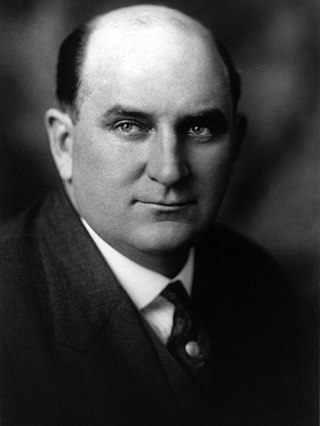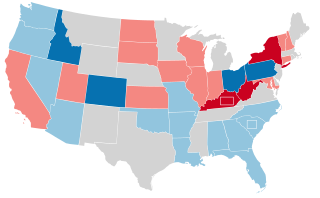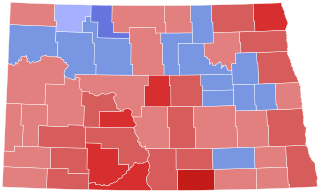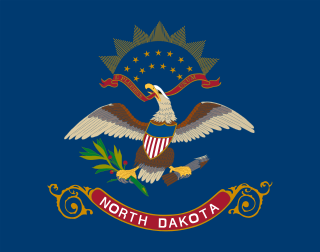Fred George Aandahl was an American Republican politician from North Dakota. He served as the 23rd Governor of North Dakota from 1945 to 1951 and as a U.S. Representative from 1951 to 1953.

Lynn Joseph Frazier was an American educator and politician who served as the 12th Governor of North Dakota from 1917 until being recalled in 1921 and later served as a U.S. Senator from North Dakota from 1923 to 1941. He was the first American governor ever successfully recalled from office. The only other American governor to ever be recalled is Gray Davis, who was recalled in 2003.

William "Wild Bill" Langer was a prominent American lawyer and politician from North Dakota, where he was an infamous character, bouncing back from a scandal that forced him out of the governor's office and into multiple trials. He was the 17th and 21st governor of North Dakota from 1932 to 1934 and from 1937 to 1939.

The 1976 United States Senate elections was an election for the United States Senate. Held on November 2, the 33 seats of Class 1 were contested in regular elections. They coincided with Democrat Jimmy Carter's presidential election and the United States Bicentennial celebration. Although almost half of the seats decided in this election changed parties, Carter's narrow victory did not provide coattails for the Democratic Party. Each party flipped seven Senate seats, although, one of the seats flipped by Democrats was previously held by a Conservative.

The 1968 United States Senate elections were elections for the United States Senate. Held on November 5, the 34 seats of Class 3 were contested in regular elections. They coincided with the presidential election of the same year. The Republicans picked up five net seats in the Senate. This saw Republicans win a Senate seat in Florida for the first time since Reconstruction.

The 1962 United States Senate elections was an election for the United States Senate. Held on November 6, the 34 seats of Class 3 were contested in regular elections. Special elections were also held to fill vacancies. They occurred in the middle of President John F. Kennedy's term. His Democratic Party made a net gain of four seats from the Republicans, increasing their control of the Senate to 68–32. However, this was reduced to 67–33 between the election and the next Congress, as on November 18, 1962, Democrat Dennis Chávez, who was not up for election that year, died. He was replaced on November 30, 1962, by Republican appointee Edwin L. Mechem. Additionally, Democrat Strom Thurmond became a Republican in 1964, further reducing Democrats to 66–34. This was the first time since 1932 that Democrats gained seats in this class of Senators.

The 1960 United States Senate elections coincided with the election of John F. Kennedy as president on November 8, 1960. The 33 seats of Class 2 were contested in regular elections. A special election was also held on June 28, 1960, for a mid-term vacancy in North Dakota where Democrats flipped a seat to expand their majority to 66–34. As Majority Leader Lyndon Johnson was elected Vice President, Mike Mansfield became the new majority leader.

The 1958 United States Senate elections were elections for the United States Senate which occurred in the middle of President Dwight D. Eisenhower's second term. Thirty-two seats of Class 1 were contested in regular elections, the new state of Alaska held its first Senate elections for its Class 2 and 3 seats, and two special elections were held to fill vacancies.

The 1956 United States Senate elections were elections for the United States Senate that coincided with the re-election of President Dwight D. Eisenhower. The 32 seats of Class 3 were contested in regular elections, and three special elections were held to fill vacancies. Although Democrats gained two seats in regular elections, the Republicans gained two seats in special elections, leaving the party balance of the chamber unchanged.

The 1946 United States Senate elections were held November 5, 1946, in the middle of Democratic President Harry S. Truman's first term after Roosevelt's passing. The 32 seats of Class 1 were contested in regular elections, and four special elections were held to fill vacancies. The Republicans took control of the Senate by picking up twelve seats, mostly from the Democrats. This was the first time since 1932 that the Republicans had held the Senate, recovering from a low of 16 seats following the 1936 Senate elections.

The 1958 United States Senate election in North Dakota took place on November 4, 1958, to elect a member of the United States Senate to represent the State of North Dakota, concurrently with other Class 1 elections to the Senate and various other federal, state, and local elections.

The 1960 Special U.S. Senate election in North Dakota was held June 28, 1960, to fill the United States Senate seat vacated by the late William Langer. Langer died in office on November 8, 1959, and Clarence Norman Brunsdale, a former Governor of North Dakota, was temporarily appointed to the seat on November 19 of that year until the special election was held. North Dakota Democratic-NPL Party candidate Quentin N. Burdick faced Republican John E. Davis for election to the seat. Davis had been serving as Governor of the state since 1957.

The politics of North Dakota were shaped historically by early settlement by people from the Northern Tier, who carried their politics west ultimately from New England, upstate New York, and the Upper Midwest. The area and state also received numerous European immigrants and migrants, particularly during the era of opening up of former Native American lands for sale and settlement.

The 2018 United States Senate elections were held on November 6, 2018. Among the 100 seats, the 33 of Class 1 were contested in regular elections while 2 others were contested in special elections due to Senate vacancies in Minnesota and Mississippi. The regular election winners were elected to 6-year terms running from January 3, 2019, to January 3, 2025. Senate Democrats had 26 seats up for election, while Senate Republicans had 9 seats up for election.

The 2020 United States Senate elections were held on November 3, 2020, with the 33 class 2 seats of the Senate contested in regular elections. Of these, 21 were held by Republicans, and 12 by Democrats. The winners were elected to 6-year terms from January 3, 2021, to January 3, 2027. Two special elections for seats held by Republicans were also held in conjunction with the general elections: one in Arizona, to fill the vacancy created by John McCain's death in 2018; and one in Georgia, following Johnny Isakson's resignation in 2019. These elections ran concurrently with the 2020 United States presidential election in which incumbent president Donald Trump lost to Democratic nominee Joe Biden.

The 1938 United States Senate election in North Dakota took place on November 8, 1938. Incumbent Republican Senator Gerald Nye ran for re-election to his third term. He faced a strong challenge in the Republican primary from colorful Governor William Langer, but narrowly won renomination. Langer subsequently ran as an independent against Nye in the general election, and won the endorsement of the Nonpartisan League. The contest effectively sidelined Democratic nominee J. J. Nygaard, and the contest between Nye and Langer devolved into sharp disagreements about the United States's foreign affairs. Nye ultimately defeated Langer by a wide margin—winning 50% of the vote to Langer's 43%—but significantly reduced from his 1932 and 1926 landslides.

The 1946 United States Senate special election in North Dakota took place on June 25, 1946. Democratic Senator John Moses, first elected in 1944, died on March 3, 1945, just two months into his term. Republican Governor Fred G. Aandahl appointed State Senator Milton Young to fill the vacancy and a special election was scheduled.

The 2022 United States Senate election in North Dakota was held on November 8, 2022, to elect a member of the United States Senate to represent the state of North Dakota. Incumbent Republican John Hoeven was first elected in 2010 with 76% of the vote to succeed retiring Democratic–NPL incumbent Byron Dorgan, and won re-election in 2016 with 78.5% of the vote. He ran for a re-election to a third term in office against Democratic-NPL nominee Katrina Christiansen. He also faced State Representative Rick Becker who initially ran as a Republican in the primary but suspended his campaign in August 2022 and instead ran as an Independent.

The 1948 North Dakota gubernatorial election was held on November 2, 1948. Incumbent Republican Fred G. Aandahl defeated Democratic nominee Howard I. Henry with 61.33% of the vote.

The 1944 North Dakota gubernatorial election was held on November 7, 1944. Republican nominee Fred G. Aandahl defeated Democratic nominee William T. DePuy with 52.02% of the vote.




















